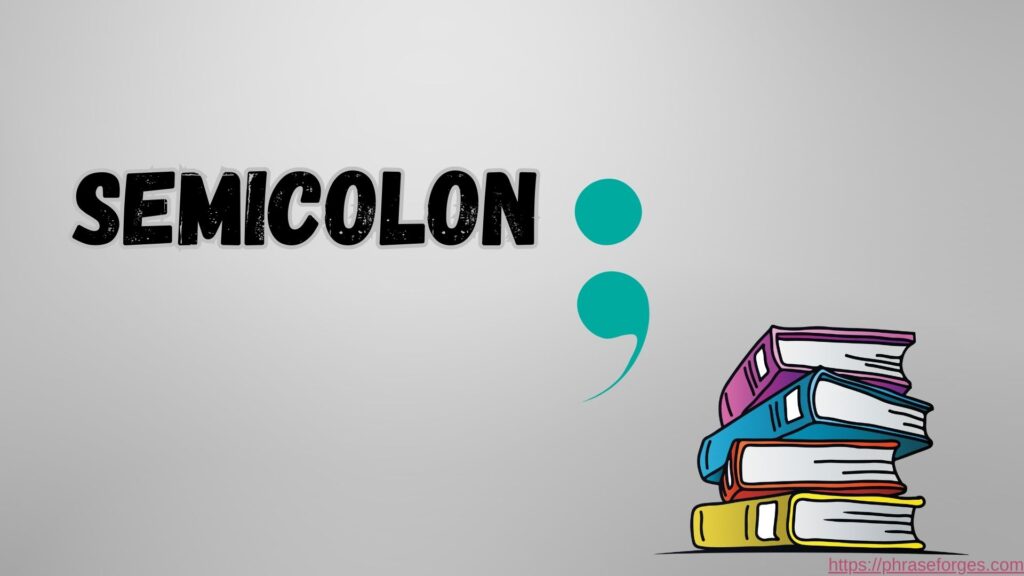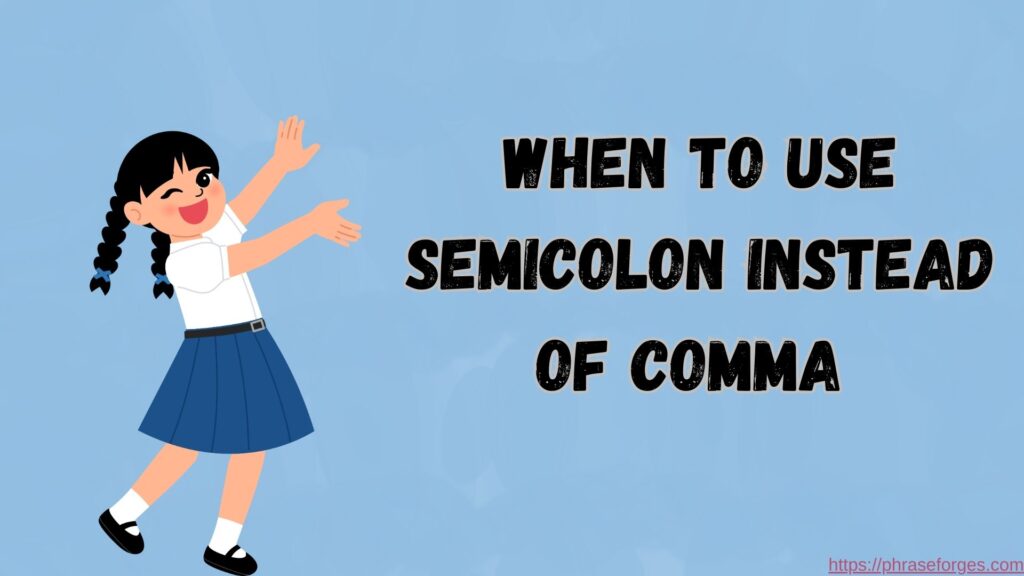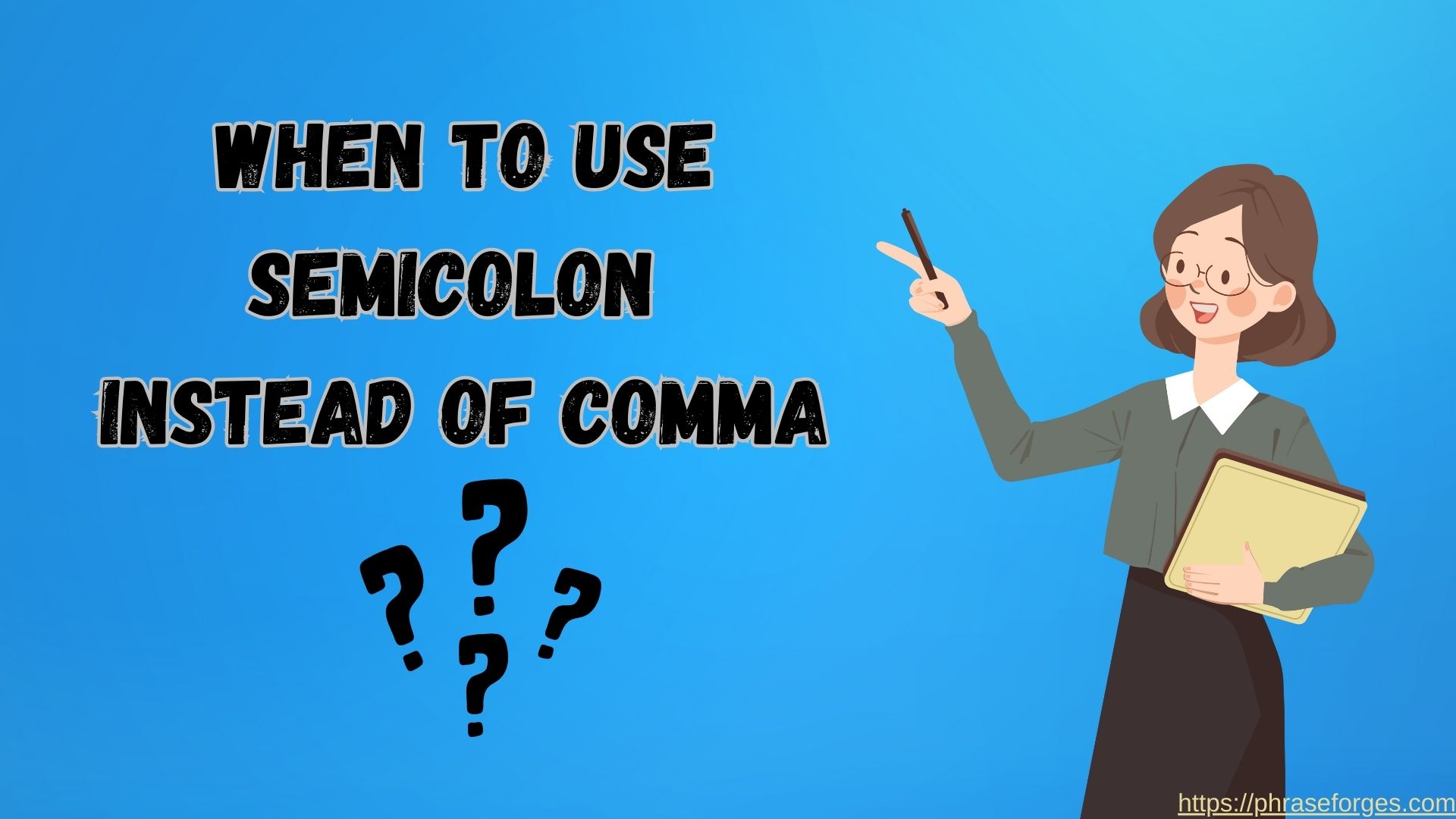Keyword + Intro Explanation
Let’s face it commas and semicolons might look similar, but they play very different roles in writing. Understanding when to use a semicolon instead of a comma can instantly sharpen your writing, whether you’re emailing your boss or crafting a college essay.
This guide walks you through exactly when a semicolon is the right choice, with clear rules, real-life examples, and a handy quick reference table at the end.
Simple Definition + Usage Overview

A semicolon (;) is a punctuation mark used to connect closely related ideas. Unlike a comma, it’s stronger and more definitive but not quite a full stop like a period.
Here’s the basic breakdown:
- A comma (,) connects parts of a sentence but can’t hold two full thoughts together without help.
- A semicolon (;) connects two independent clauses (complete thoughts) without a conjunction like “and” or “but.”
- It also helps when you’re making lists that are already full of commas.
Clear Rules & Patterns
Let’s simplify when to choose a semicolon instead of a comma.
H3: 1. Use a semicolon to join two related full sentences
If the thoughts could stand alone as complete sentences, and they’re closely related, use a semicolon instead of a comma.
✅ Correct:
I finished the project early; now I can relax.
❌ Incorrect (comma splice):
I finished the project early, now I can relax.
This is one of the most common misuse cases, where a comma tries to do the job of a semicolon.
H3: 2. Use semicolons in complex lists
If you’re listing items that include commas within them, use semicolons to separate the list items.
✅ Example:
The team includes Rachel, the project manager; John, the developer; and Priya, the designer.
Without semicolons, it’s easy to misread who does what.
Bulleted Rules with Do’s/Don’ts
✅ Do use a semicolon when…
- You’re joining two related complete sentences without a conjunction
- Your sentence lists multiple items that have internal commas
- You’re using transitional phrases like however, therefore, on the other hand, etc.
❌ Don’t use a semicolon when…
- One or both parts of the sentence are incomplete
- You’re trying to fix a sentence that needs a conjunction, not stronger punctuation
- You’re separating items in a simple list without internal commas
Multiple Example Sentences
Let’s make this real. Here’s how you might apply semicolons in actual writing:
Email Example:
Subject: Team Offsite Planning
Hi Jasmine,
We’ve locked in the schedule for the retreat; the final version is attached.
The itinerary includes sessions with Marcus, our strategy lead; Dana, the guest speaker from Salesforce; and Tara, who’ll run the mindfulness workshop.
Let me know if you’d like to add anything.
Thanks,
James
Before/After Examples in Everyday and Formal Contexts
Informal Writing – Before:
I’m really tired, I stayed up all night. (comma splice)
After (Corrected):
I’m really tired; I stayed up all night.
Formal Writing – Before:
The data shows improvement, however, further analysis is needed. (awkward comma use)
After (Corrected):
The data shows improvement; however, further analysis is needed.
See the difference? In both cases, semicolons bring clarity where commas fall short.
Common Mistakes & Fixes

A lot of confusion around semicolons comes from trying to use them like fancy commas. Let’s clear that up.
Mistake 1: Using a comma between two independent clauses
❌ We launched the campaign, the traffic spiked.
✅ Fix: We launched the campaign; the traffic spiked.
Mistake 2: Using semicolons with coordinating conjunctions
❌ She likes coffee; but he prefers tea.
✅ Fix: She likes coffee, but he prefers tea.
Why? The semicolon and “but” together is overkill. If you use a coordinating conjunction (and, but, or, so, etc.), use a comma not a semicolon.
Mistake 3: Skipping semicolons in complicated lists
❌ Attendees include Kim, the HR lead, Steve, marketing, and Alex, tech.
✅ Fix: Attendees include Kim, the HR lead; Steve, marketing; and Alex, tech.
Semicolons untangle complex items and make your writing easier to follow.
Quick Reference Table
Here’s a one-stop table you can save for your future writing sessions:
| Scenario | Use Semicolon? | Why |
|---|---|---|
| Joining two full, related sentences | ✅ Yes | Shows close relationship without a conjunction |
| Separating items in a list with internal commas | ✅ Yes | Prevents confusion between items |
| Between dependent and independent clauses | ❌ No | Use a comma or conjunction instead |
| Before transitional phrases (e.g., however) | ✅ Yes | Improves sentence clarity and flow |
| With simple lists (e.g., apples, bananas, pears) | ❌ No | A comma is all you need |
| With conjunctions like “and,” “but,” “or” | ❌ No | Use a comma instead |
Wrap-Up: How to Instantly Level Up Your Writing
Using semicolons correctly might seem intimidating at first, but once you understand their role, it’s like unlocking a secret weapon in punctuation.
Think of the semicolon as the cool, collected older sibling of the comma able to handle more weight, more complexity, and bring more control to your sentences.
Whenever you’re editing an email, report, or even a social post, pause and ask yourself:
- Are these two ideas both full sentences?
- Do they relate closely enough to sit together without a conjunction?
- Is my list getting confusing with all these commas?
If the answer’s yes, it might be time to bring out the semicolon.
And remember: punctuation isn’t about rules for the sake of rules it’s about helping your ideas shine clearly and confidently.

